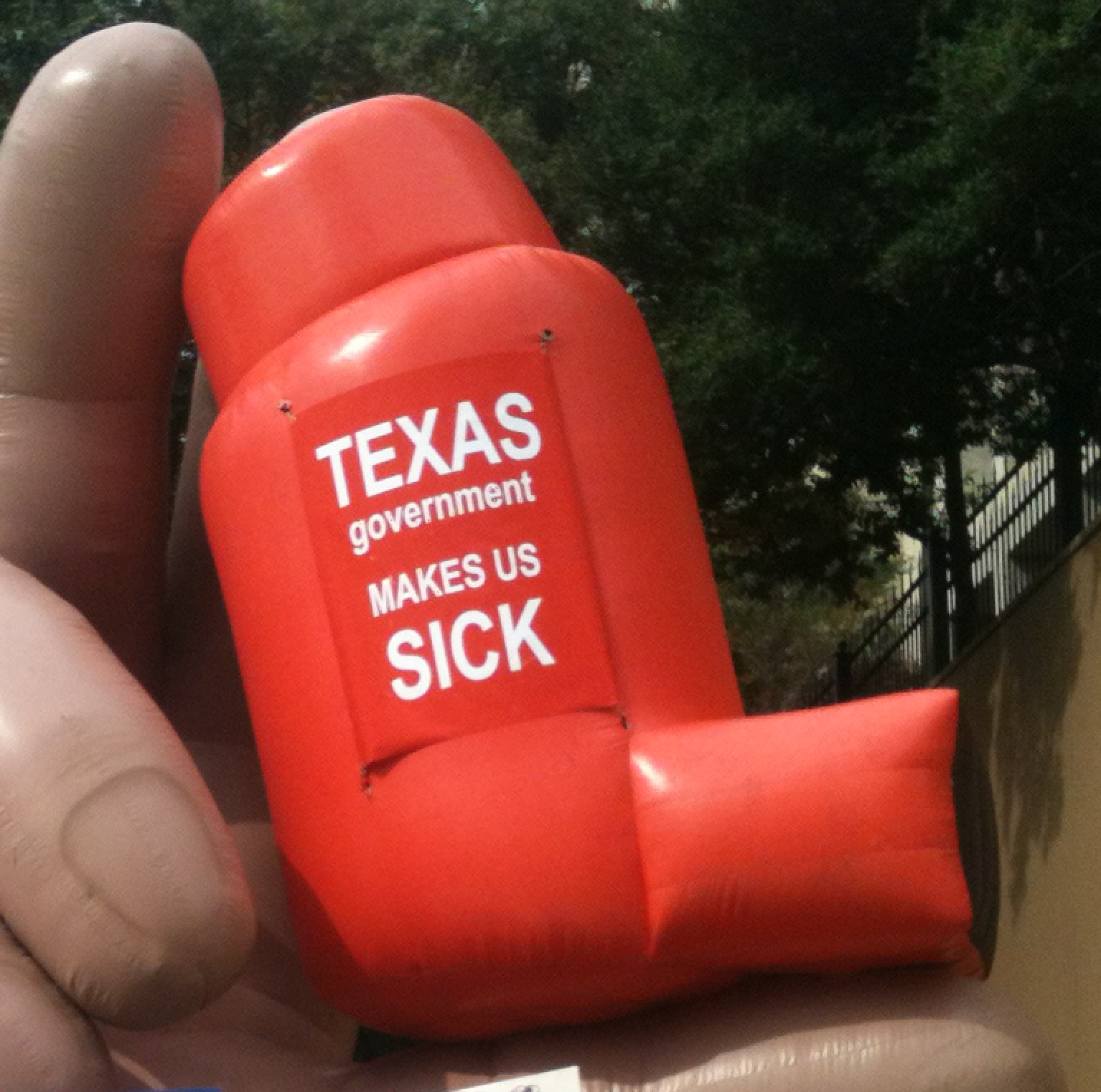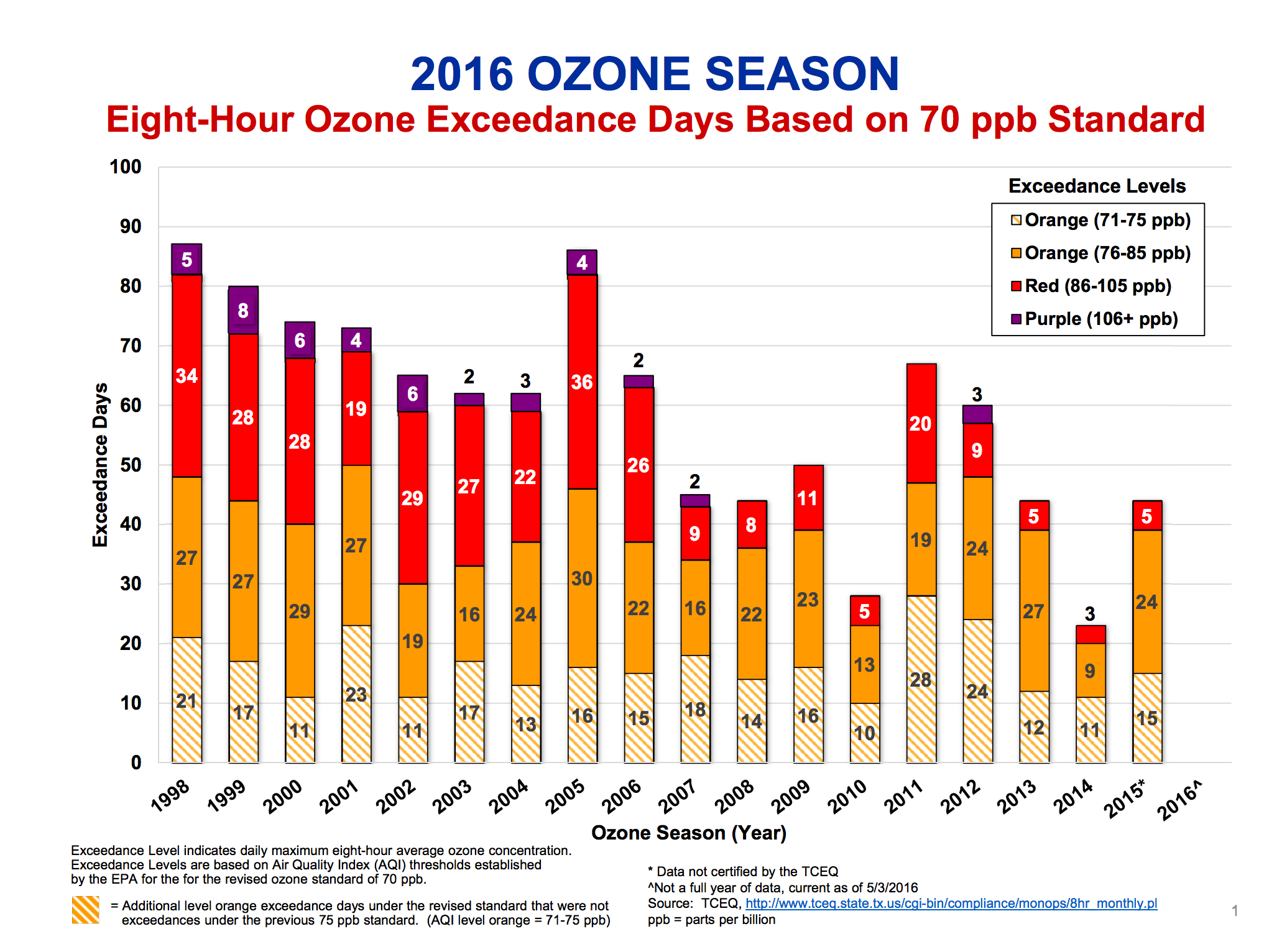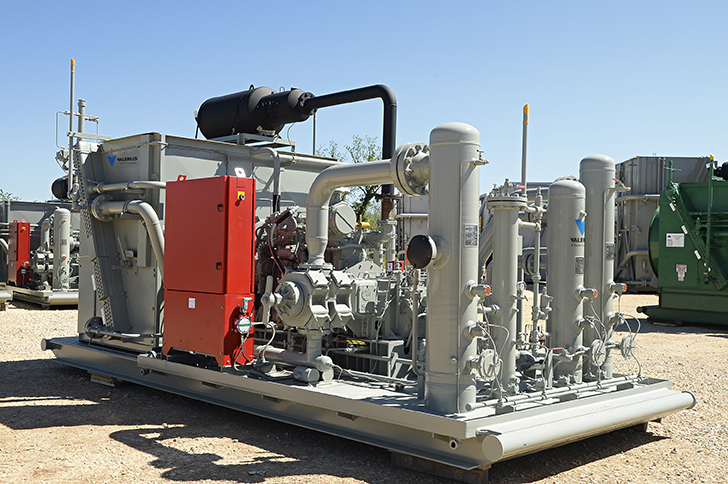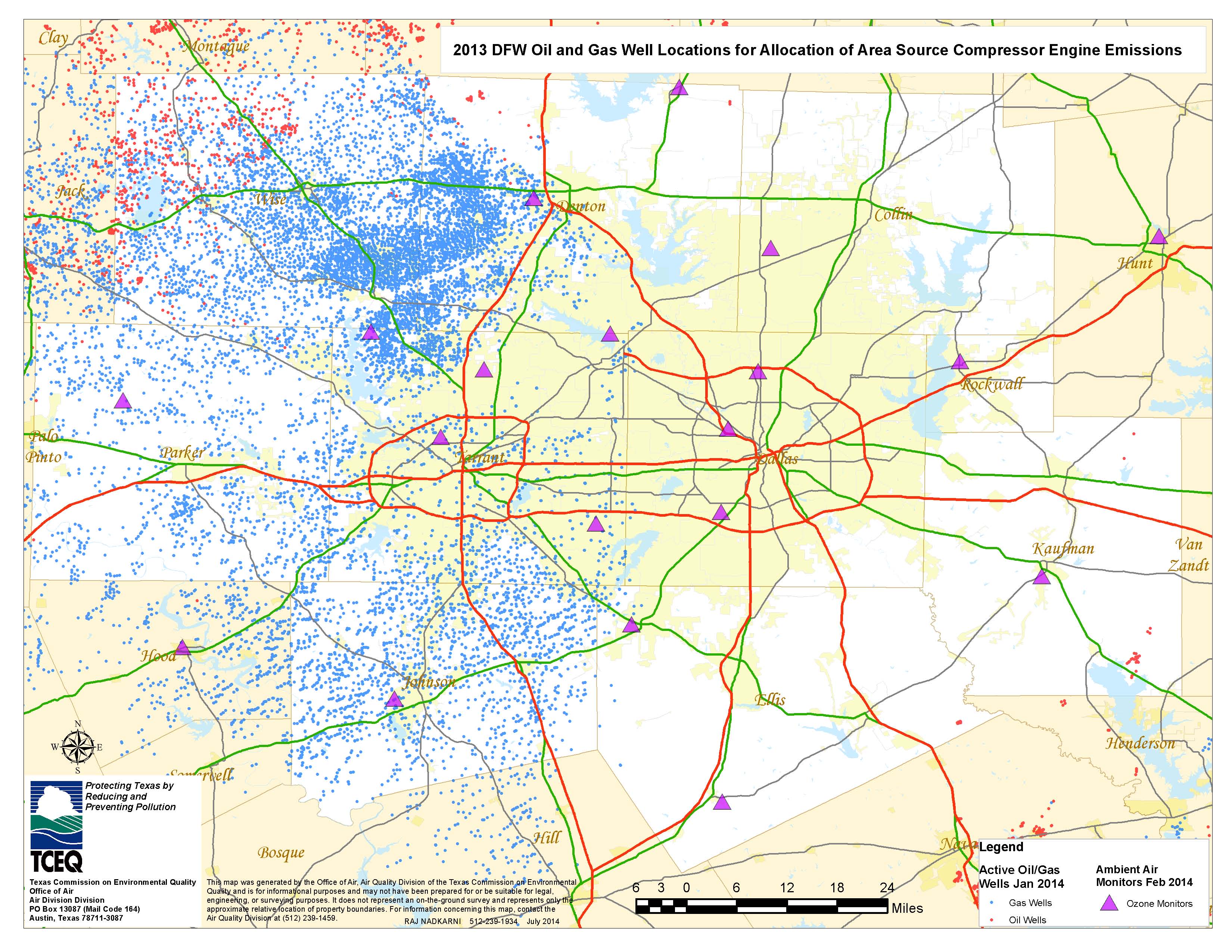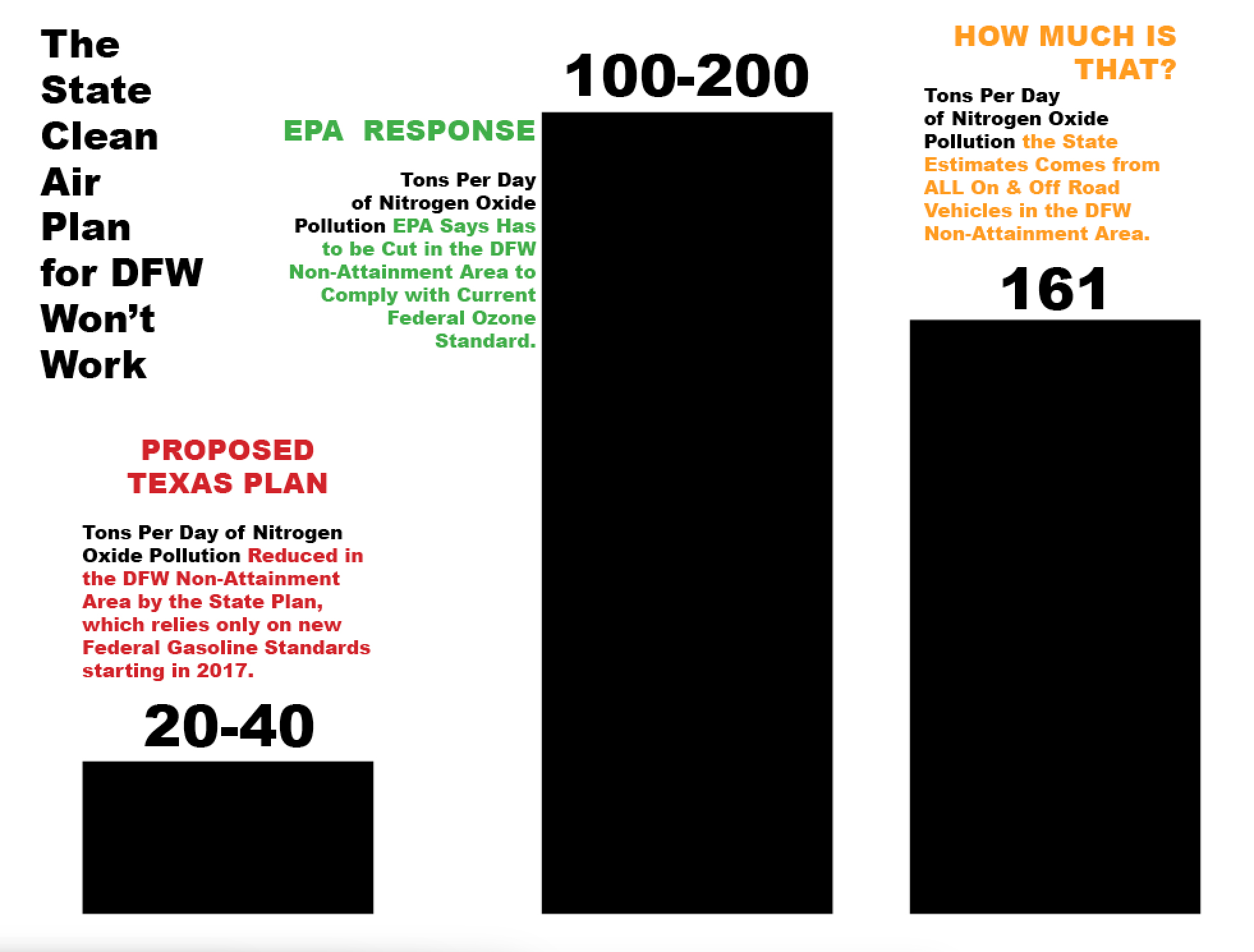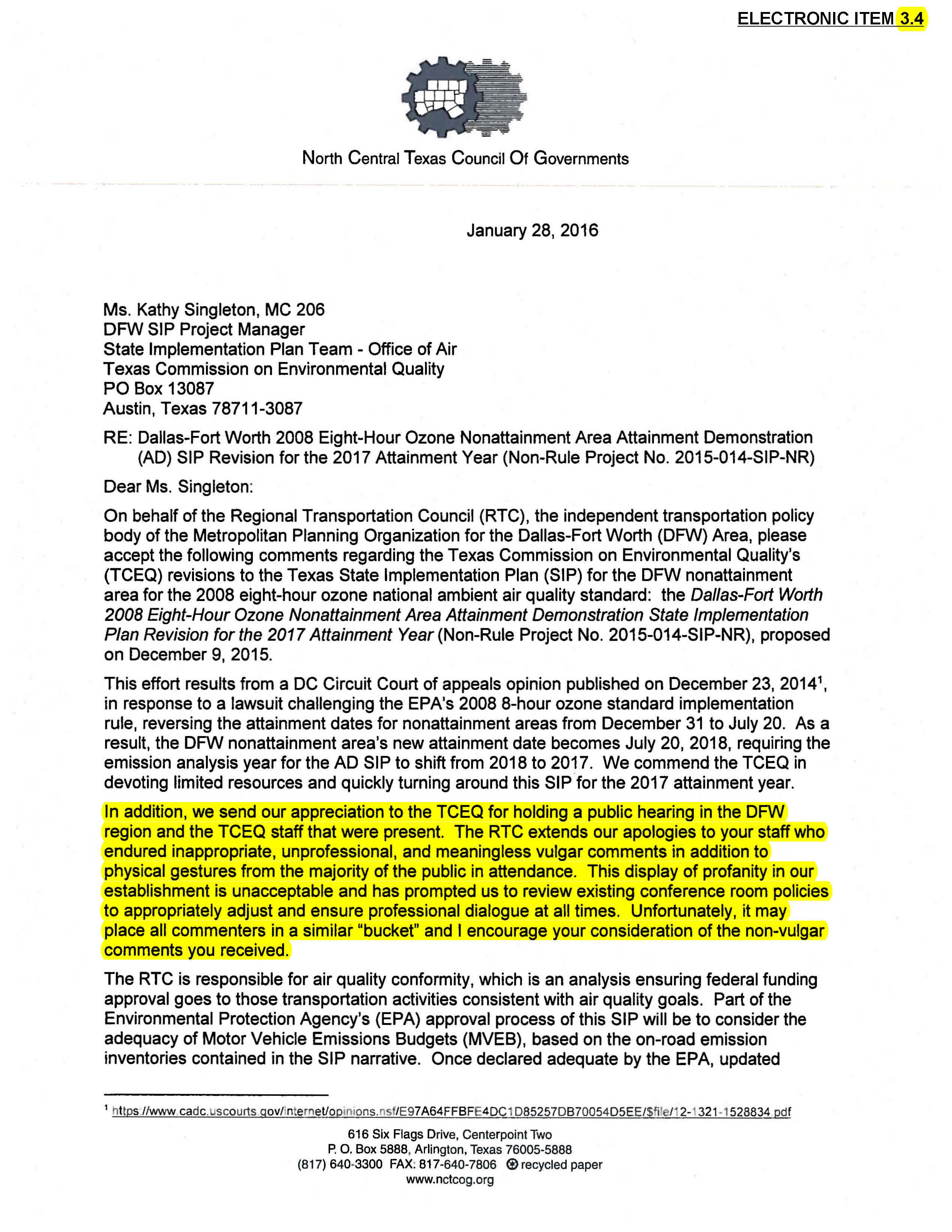DFW SIP
Summer Isn’t Coming, It’s Here. Ozone Season Arrives with a Vengeance.
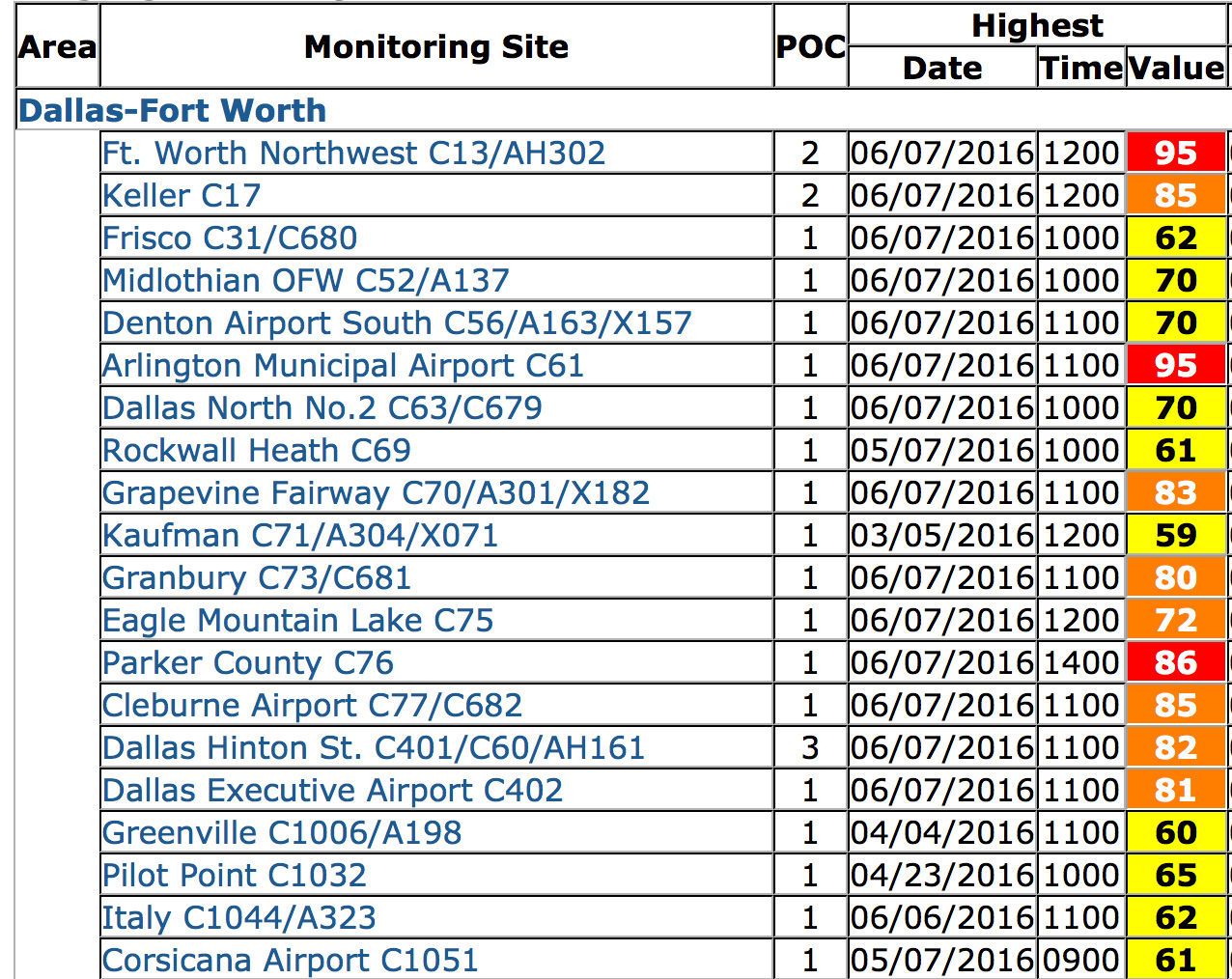 Yesterday was the single worst day for DFW smog in the last three years.
Yesterday was the single worst day for DFW smog in the last three years.
Seven monitoring sites stretching from central Dallas to Weatherford saw hourly averages of 90+ parts per billion. Three sites in Arlington, Northwest Fort Worth and Keller saw levels reach 100 + ppb. Two of those sites saw hourly levels climb to 113 ppb. To give you some idea of how bad that is, the original dreadful, obsolete standard during the 1980's and early 90's was 125 ppb in a single hour. We probably came within an hour or two of reaching a level of air pollution at not one, but two sites yesterday that would have exceeded a 40-year old smog standard.
14 out of the 20 DFW monitors recorded average ozone "exceedences" that violated the current 75 ppb 8-hour standard (what you see above). Two sites saw 8-hour averages of 95 ppb, the worst showing since September 2013.
It became a hazard to breathe for hundreds of thousands, maybe millions of DFW residents, yesterday afternoon. South Arlington residents experienced unhealthy levels of air pollution from 12 noon to 7 pm. In Keller it was 2 to 7 pm.
The good news? It could have been worse. The only thing preventing even higher numbers was the changing wind direction in mid-day. Monitors located in Dallas were recording high smog levels in the morning and lunchtime from northerly winds, but then they turned east and the pollution headed west, raising smog levels across broad swaths of Tarrant, Johnson, and Parker Counties. Had the wind been coming from the east all day, you would have seen the numbers those monitors reached at 2 -5 pm happen sooner, with more room to grow.
Wednesday also looks to be a bad day, as does the rest of the week of full-bore summer sunshine. Bad as they were, none of yesterday's exceedences actually count as a Clean Air Act violation…yet. It takes four bad days where the 8-hour average exceeds the 75 ppb standard over the course of the ozone season to make a violation. Regulators only use the fourth highest smog level recorded at each site to determine the annual average and whether an area is meeting the Clean Air Act standard (you can keep track of those here). Yesterday, nine monitors recorded their first exeedence of the year. Only three more to go.
However, the region's current reigning bad air champ, the Denton airport monitor, uncharacteristically remained out of harm's way and saw levels barely above the 75 ppb standard in mid-afternoon. It'll have it's chance. Summer is only beginning.
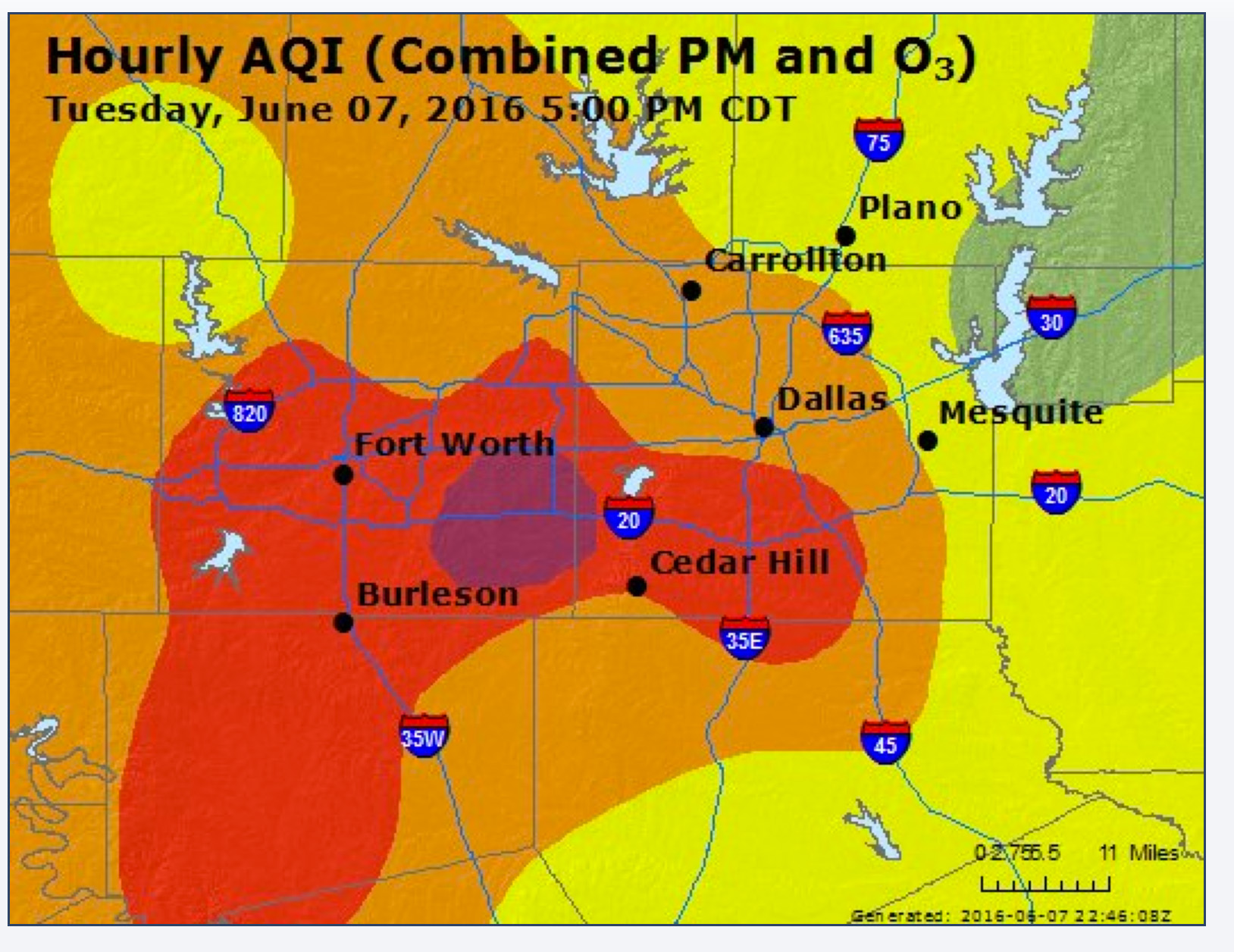 Tuesday's smog attack put an exclamation point in front of next Wednesday's Dallas City Council scheduled vote on Councilwoman Sandy Greyson's air quality resolution rejecting the current state plan – ain't it working out swell!? – in favor of a plan to eliminate days like yesterday.
Tuesday's smog attack put an exclamation point in front of next Wednesday's Dallas City Council scheduled vote on Councilwoman Sandy Greyson's air quality resolution rejecting the current state plan – ain't it working out swell!? – in favor of a plan to eliminate days like yesterday.
Greyson's resolution requesting a new and better clean air plan, as well as the staff presentation that provided background information, can be reviewed here. It's similar in content to one passed earlier in May by Dallas County.
Supporters can sign-up to speak for 3 minutes each when it comes up on the agenda and as always, we'll have plenty of lapel pins with the DFW Clean Air Network logo on them so you can non-verbally support the resolution as well.
If you want to speak at the Council meeting in favor of clean air, please contact the City Secretary beginning at 8:15 am tomorrow, Thursday, June 9th at (214) 670-3738 to reserve a 3-minute speaking slot or Item #12 on the "consent agenda."
Consent agendas are tricky things. They require complete unanimity among all 15 council members and are usually reserved for the most benign, non-controversial subjects. So at first glance, it's a good thing our resolution is on the list because it implies support from all 15 members.
But, and it's a big but….any member who doesn't agree it should be on the consent agenda can ask that it be taken off and placed in the "Items for Individual Consideration" bin – kind of like going to the back of the line and waiting for all the other business to get done before re-visiting the matter.
If there's industry opposition, or any opposition for that matter, it would give a council member an excuse to take it off the consent agenda and send it to the back of the line in hopes us cooling our heels and losing speakers as the day wears on. And it only takes one council member disagreeing to do so. This is why we need you to send emails to ALL 15 council members.
Since it's on the consent agenda, at least for now, it'll be among the first orders of business next Wednesday. Supporters need to show up at 9 am sharp.
Dallas passing this resolution would mean that the most populous city in the DFW "non-attainment area" for smog is rejecting the anti-science "do-nothing" approach of the State and demanding a better strategy to actually clean up chronic air pollution.
That's exactly the kind of statement local governments have to send EPA in order for the federal agency to screw-up enough courage and reject the current state proposal in favor of something better.
And after yesterday, is there anyone outside of Austin who believes we don't need something better?
Dallas City Council Clean Air Vote
Wed. June 15th 9am
Dallas City Hall 1500 Marilla
Dallas Council Committee Votes for Air Quality Resolution, Heads for Full Council Vote in June
SEND A "CLICK N SEND" EMAIL TO ALL 15 DALLAS CITY COUNCIL MEMBERS URGING THEM TO VOTE FOR CLEANER AIR IN JUNE
By a vote of 5 to 1 the City of Dallas moved closer to joining Dallas County in repudiating the State's do-nothing DFW clean air plan and demanding something better.
It was the second vote in less than a month to condemn an anti-smog strategy the Texas Commission on Environmental Quality claims gets DFW "close enough" to the current federal standard, but is criticized by clean air advocates as inadequate to end the region's chronic bad air problem.
In April U.S. Congressional Representatives Eddie Bernice Johnson and Marc Veasey asked the EPA to reject the State plan and write its own.
Council members Mark Clayton, Philip Kingston, Tiffini Young, and Rickey Callahan backed a wide-ranging air quality resolution sponsored by Quality of Life Committee Chair Sandy Greyson. Casting the lone no vote was Adam McGough.
Greyson's resolution cites the EPA's conclusion "that the latest air quality State Implementation Plan (SIP) proposed by the Texas Commission on Environmental Quality (TCEQ) is not adequate to address the (the region's) ozone concentrations"
One reason given for the inadequacy is the plan doesn't touch major sources of air pollution affecting DFW including the East Texas coal plants, the Midlothian cement kilns and oil and gas facilities. The resolution specifically requests the state to follow the prescription laid out by UNT's landmark 2015 DFW ozone study, itself based on the State's own computer air model by adding off-the shelf control technology to those industrial sources.
Besides rejecting the state's plan, the resolution also takes issue with the State's assertion that lowering smog levels won't improve public health by specifically adding a provision stating "…studies have shown a direct correlation between health issues, such as asthma and chronic obstructive pulmonary disease, and higher levels of ozone…"
It also calls for more renewable energy, net metering and an endorsement of the Obama Administration's Clean Power Plan – a 2016 Dallas Omnibus Air Quality resolution.
Nobody had anything nice to say about the Texas Commission on Environmental Quality, and Councilman Philip Kingston was particularly pointed in his criticisms. During a discussion about Dallas taking on some of TCEQ's enforcement duties, Kingston explained why the City preferred to to it themselves, rather than leave it up to the State: "Because they do the same thing with that responsibility as they do with all their responsibilities – they ignore them." Amen.
The resolution now goes to the full Dallas City Council for a final vote at one of two meetings before the summer break – either June 15th or June 22nd. Stay tuned for details.
Meanwhile, RIGHT NOW – you can send a quick e-mail toall 15 Dallas City Council members asking them to vote for the Greyson air quality resolution when it shows up on their doorstep. You can add a message of your own if you want.
Why a small variance could mean a big increase in DFW smog
Thousands of gas wells, pipelines, storage tanks, compressors, and other pieces of infrastructure in oil and gas patches, which individually don't emit the huge volumes of air pollution coming from a single cement kiln or a coal plant can, when combined, easily total tonnage larger than both.
And that's what has happened in DFW over the last decade. As the Barnett Shale boom crept further into the region's "non-attainment" area" for smog, all the air pollution from all those thousands of individual sources begin adding up and having an impact on air quality.
While other large sources were actually decreasing their pollution, the oil and gas sector was going the opposite direction. It ballooned. To the point where it's now the fourth largest category of air pollution in that "non-attainment area." The three sources that outrank it? 1. All vehicles on the road. 2. All vehicles off-the-road, and, 3."area sources" a catch-all term including everything from backyard BBQs to small paint shops, and probably some oil and gas sources itself. Oil and Gas air pollution is, by volume, now the largest source of industrial air pollution in the North Texas area, exceeding the Midlothian cement kilns, local power plants (now all gas-fired), and large manufacturing plants like the GM truck and SUV factory in Arlington. Only the East Texas coal plants emit more and their 90-100 miles outside the nonattainment boundary (another problem that needs fixing).
At the same time oil and gas air pollution rose from Barnett Shale development, DFW smog levels, which had been declining, began to plateau. For a decade now the annual smog average has hovered on either side of 85 parts per billion (ppb) – the obsolete 1997 standard that we were supposed to reach in the early Oughts. We were at 86 ppb of smog in 2008 and we're now at 83 ppb.
Look at the chart below, generated by the North Texas Council of Governments. In 2007 DFW had 45 "exceedence days". In 2015, DFW had 44 "exceedence days." There's a very good case to be made that oil and gas air pollution has prevented DFW from making the kind of air quality progress it might have otherwise made without that burden.
For the last five years, the State of Texas has been on a mission to deny any link at all between the oil and gas industry in the Barnett Shale and DFW smog. It's gone out of its way to hide the real volumes of pollution emitted by these sources, as well as avoiding or downplaying the significance to regional air quality of decreases in that pollution. That's not hyperbole, it's the record.
In looking ahead with its proposed DFW air plan now in the pipeline, the State has predicted that a drop in the number of new wells in the Shale will equal a drop in the amount of air pollution coming from O&G sources. Sounds logical doesn't it? Yet the industry's own text books say that it ain't necessarily so.
A drop in new wells is the tip of the O&G iceberg in DFW. Just because there were no new wells drilled last month doesn't mean there's no new pollution being released this month. Some 20,000 wells, almost 1000 large compressors, untold thousands of smaller compressors, millions of gallons of storage capacity, miles of pipelines – these all continue to operate and emit huge amounts of air pollution 24/7.
And when production-per-well drops, and the densest parts of the patch begin to play out, as is occurring now in the Barnett, investors don't usually go with the flow. They want to increase the flow. And so they install more "lift compressors" to squeeze every last molecule of gas they can out of a well. These compressors, powered by gas or diesel, increase air pollution. Not by a lot by themselves, but when you start putting them together, by the thousands, then yeah, they have an impact. And so, even when O&G production is declining, you can have increases in O&G air pollution.
Downwinders at Risk and the Sierra Club made this argument in our comments about the state's plan, providing sources from industry to show exactly how this has taken place plenty of times before. We told Austin it was underestimating the impact of O&G air pollution – again. The State dismissed our concerns and said no problem.
Which brings us to Mansfield in Tarrant County, scene of the last pre-HB40 gas ordinance fight in the state.
Last week, there was a small headline in the Fort Worth Star-Telegram a lot of people probably ignored. It concerned a routine variance to zoning code being requested by (notorious) gas well operator EagleRidge. At issue was whether the company could keep using gas powered lift compressors instead of electric-powered ones as the city's year-old ordinance required. EagleRidge made an argument in favor of the variance which sounded very familiar to some of us….
EagleRidge first noticed a dramatic decline in natural gas production at 15 of its wells last year, as it went from 8 million to 2.5 million cubic feet of natural gas per day. Low natural gas prices, trading about $2.10 per British thermal unit Monday, could make the wells economically unfeasible, according to Mark Grawe, executive vice president of EagleRidge.
That prompted EagleRidge to try a new strategy, using small gas lift compressors that increase production on the wells. Last year, Mansfield granted a six-month variance to allow the compressors on a trial basis.
Grawe said the compressors have already improved production on three of the wells, but addition tests are needed on EagleRidge’s other wells.
Eagle Ridge got its variance. And besides the three lift compressors it's operating on the site now, at least two to three more or expected, and all of those might one day be replaced by two giant-sized compressors. And, Eagle Ridge told the council, it's experience in Mansfield will be repeated at "hundreds of wells in Southeast Tarrant County" that have also seen declining production.
Eagle Ridge's ratio was approximately one lift compressor for every two wells. There are 15 wells as part of this one variance, "hundreds" in SE. Tarrant County waiting their turn, and 20,000 more throughout the part of the Barnett Shale in the DFW non-attainment area for smog. That's thousands and thousands more lift compressors emitting lots more air pollution even as Barnett Shale production is declining – and most will be located in cities or counties where there's not even a requirement for electric power to get a variance from. In other words, this is exactly the scenario Downwinders and the Sierra Club warned about in their comments, but which the state dismissed.
That's in addtion to the thousands of lift compressors already located in DFW, the exact number and location of which are unknown to EPA and Texas because they don't require indivdual permits. Austin "estimates" the total amount by using, you guessed it, production numbers. Here'a map from the Texas Commission on Environmental Quality guestimating where all those existing lift compressors are now:
If you think there might be a correlation between O&G pollution and stagnating DFW smog levels, what's the answer? It's pretty straight-forward. Stricter emission standards for all equipment, leak detection, electrification of large and small compressors. These are all things the industry is either doing in fits and starts in North Texas and elsewhere, or being required by the new EPA methane rules, but they're not being applied across the board in the Barnett Shale, or they don't apply to existing facilities, or both.
Who's going to make that happen? Local governments were doing some of it – up until the passage of HB40. For example, Dallas, Mansfield, and other cities required electric-powered compressors and state-of-the-art leak detection. But that's off the table, as is any action from Austin. That leaves the EPA as the one regulatory entity that could, if it wanted, impose uniform emission standards on all O&G facilities in the 10-county non-attainment area, including Denton, Johnson, Parker, Tarrant, and Wise counties. It could do so as part of it's own anti-smog plan for the region.
But before it can start writing its own plan, the EPA must first reject the state's. And for it to do that we must give the EPA the political support it needs to stand up to the backlash from Austin you know will come. Thus the need for resolutions from DFW cities and counties asking the EPA to reject the State plan. Thus the need to show-up this coming Monday morning at City Hall and support an effort by Dallas City Councilwoman Sandy Greyson to have the City of Dallas join Dallas County in calling for EPA intervention in DFW air quality: 9am Room 6ES, Quality of Life Committee.
Don't let the Mansfield variance become the regional template.
Dallas County Votes to Reject State Air Plan, Asks EPA for Help
 By a vote of 3 to 2 this morning Dallas County became the first local government in DFW to take a stance rejecting the state-sponsored anti-smog plan for the area, and ask EPA for help in writing a new one that might actually produce cleaner air.
By a vote of 3 to 2 this morning Dallas County became the first local government in DFW to take a stance rejecting the state-sponsored anti-smog plan for the area, and ask EPA for help in writing a new one that might actually produce cleaner air.
At stake is the last comprehensive chance to address chronic smog in North Texas until the next decade.
Pct 1 Commissioner Dr. Theresa Daniel introduced the resolution. It garnered support from Dallas County Judge Clay Jenkins and Pct 4 Commissioner Elba Garcia.
One-by-one Judge Jenkins cited, and then shot down, arguments he said he'd heard from industry about East Texas jobs, electric grid reliability, and the "premature" nature of the vote, given that the state's plan doesn't officially arrive at the EPA's doorstep until July. He said he found none of these persuasive in light of the impact to public health and lost productivity from dirty air days in Dallas County cited in Dr. Robert Haley's landmark 2015 study on the costs of smog in DFW. And he saw no indication the state was planning to change anything in the plan prior to July's official submission.
Garcia was hopeful that the measure, although without the weight of law, would still be effective in getting the EPA to provide a more effective clean air plan.
Daniel cited the fact the area has continually been out of compliance with the Clean Air Act since 1991 despite five previous state air plans as evidence of something more being needed this time around. She also reminded the Court of the conclusions of the UNT's ozone study, based on the state's own computer air modeling, showing the East Texas coal plants to be the single biggest influence on DFW smog.
Commissioner John Wiley Price, facing federal corruption charges, gave perhaps the most puzzling and incoherent defense of dirty air ever heard inside a local governmental chamber. He seemed to be adopting the TCEQ party line in arguing that the coal plants weren't impacting DFW air and the Court's actions were "premature" – he latched on to Jenkins phrase like a drowning man to a floating log. But honestly, there weren't a lot of complete sentences to his explanation. Which is a shame, because when you talk about who pays the price for dirty air in Dallas County, a disproportional number of those casualties are Commissioner Price's constituents – people of color who make less than the median income. They need a strong advocate for clean air, not a rambling echo chamber for the failed status quo.
Commissioner Mike Cantrell, the lone Republican on the court, did not speak at all. Such is the state of the Texas Republican Party.
Dallas County's resolution now goes to EPA, will it will join a letter sent two weeks ago by Dallas area congressional representatives Eddie Bernice Johnson and Marc Veasey, which also requested EPA reject the state's plan and write one of its own if it has to.
Meanwhile, clean air advocates are fanning out and seeking appointments with representatives from other North Texas counties and cities to attempt to get as many similar resolutions as they can between now and the end of the year, when a final decision could be made by EPA to accept or reject the plan. They say the more local governments that pass them, the more likely it is EPA will feel it has the political support to intervene.
Because Dallas District 12 Councilwoman Sandy Greyson served with Commissioner Daniel on the same committee overseeing the UNT and Haley studies, it's probable Dallas City Hall will be one of the next front lines in this fight. Stay tuned.
Join Us for the First DFW Air Quality Vote of 2016
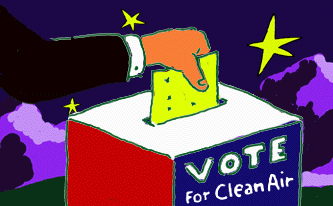 Dallas County Commissioners' vote on sending state air plan back to Austin:
Dallas County Commissioners' vote on sending state air plan back to Austin:
This Tuesday, May 3rd, 9 am 411 Elm Downtown Dallas
First air quality vote of 2016
Come help us thank local officials for standing up to the state
This next Tuesday, May 3rd, the Dallas County Commissioners Court will hold an historic vote.
Commissioners will be asked to go on record as the first local North Texas government urging the EPA to reject the currently proposed state air plan for DFW and replace it with a stronger one that actually cuts pollution.
Pct. 1 Commissioner Theresa Daniel is sponsoring a resolution that requests EPA to do two things:
"…to reject the proposed State Implementation Plan for DFW ozone pollution, and require a new federal DFW clean air plan that can meet or exceed the current 75 ppb federal ozone standard at all North Texas monitoring sites, and implement all reasonably available pollution controls as defined by the federal Clean Air Act.
and
"...regulate East Texas coal plants as if they were in the DFW non-attainment area, or include them in a larger non-attainment area for North Texas under rules governing the new federal 70 ppb ozone standard."
As the most populous county in the 10-County DFW "non-attainment area" for smog, Dallas carries a lot of political weight. Passing such a resolution would be an important signal to other local officials concerned about the two-decade plus chronic air pollution problem in the region.
Downwinders and other citizens groups have formed a new ad-hoc alliance to campaign for similar resolutions in other North Texas cities and counties as part of a broader effort of convincing EPA to replace another state "do-nothing" air plan with one of its own.
The DFW Clean Air Network, or DFW CAN, includes the Dallas Sierra Club, and the Sierra Club's Beyond Coal campaign,Public Citizen Texas, Mansfield Gas Well Awareness, Liveable Arlington, and Texas Campaign for the Environment.
It's important to recognize what a challenge Commissioner Daniel and others are facing in taking on Austin over this issue. They need to see your support for their brave stands. And all the Dallas County Commissioners need to be reminded how long we've had to breathe dirty air and why we're fed-up with the state's apathy.
We CAN win this vote.
We CAN make a difference.
We CAN breathe clean air.
Bring the East Texas Coal Plants into DFW’s Smog “Non-Attainment Area” and See How Long They Last……
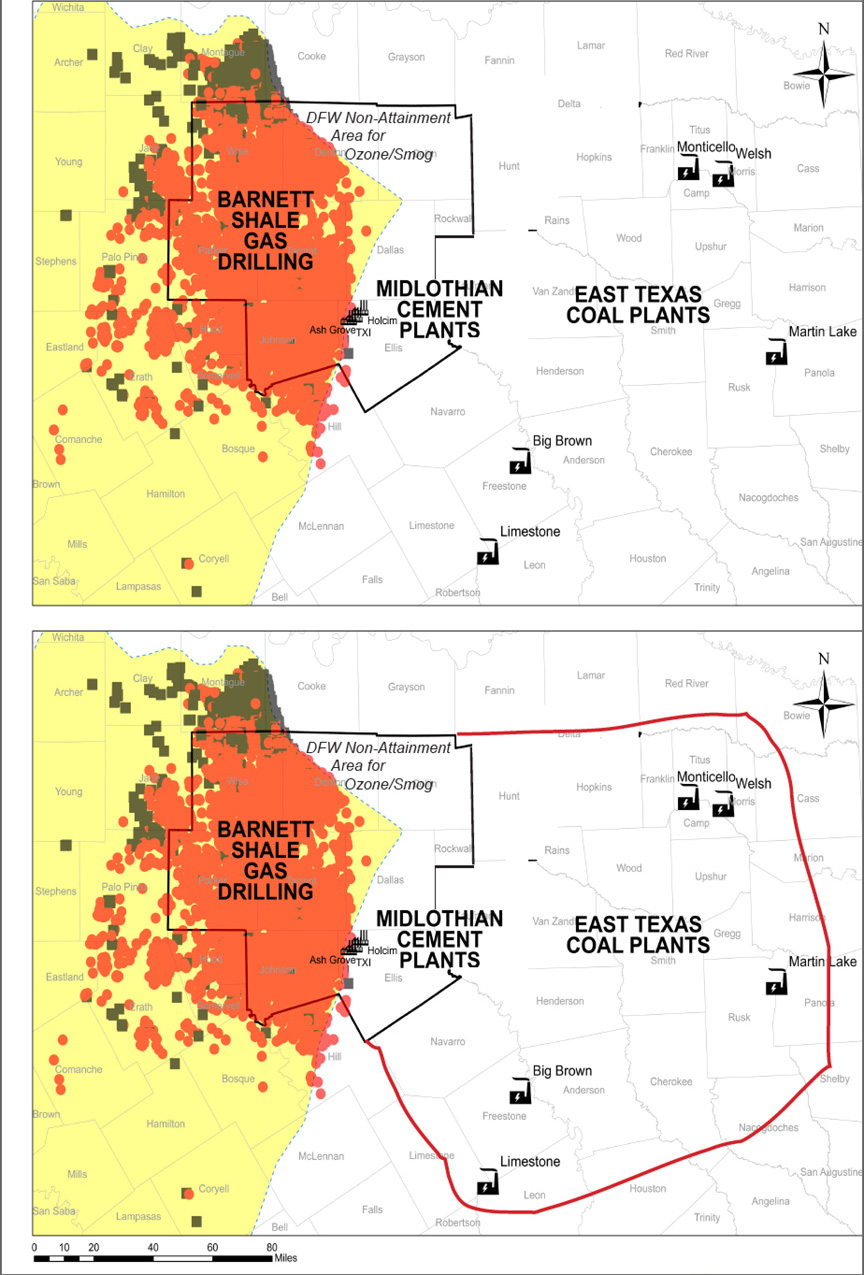 Want the Coal Plants to Face the Kind of Regulation
Want the Coal Plants to Face the Kind of Regulation
They've Been Avoiding for Decades?
Click here and send a formal comment letter demanding the coal plants
be included in the new DFW non-attainment area for smog.
Even as we're all waiting to see what EPA decides to do about the current Texas air plan for DFW under the current 75 ppb ozone standard, the regulatory process is gearing-up to administer the new 70 ppb standard.
One of the things which must be decided by the EPA are what geographical boundaries to use for the new standard when it comes to the DFW airshed and its chronic smog condition. Should they stick with the current 10-County configuration or should it be different and/or more inclusive?
The history of DFW's smog fight is a lengthy chronicle of bringing new counties into the fold despite official resistance. Originally, the DFW non-attainment area was only Tarrant, Dallas, Collin and Denton. Then Rockwall, Parker, and Johnson Counties came in because of their commuter traffic.
Downwinders had to petition the EPA to bring Ellis County and its cement industrial complex into the non-attainment area early in this century after being told repeatedly by state officials that its pollution had no impact on DFW air quality.
More recently, the state argued against the inclusion of Wise County, despite its huge inventory of oil and gas pollution, population of commuters, and more than likely, the highest ozone levels of anywhere in North Texas. EPA decided to bring it in anyway.
We're once again at a crossroads, and it could be the most significant one in a decade.
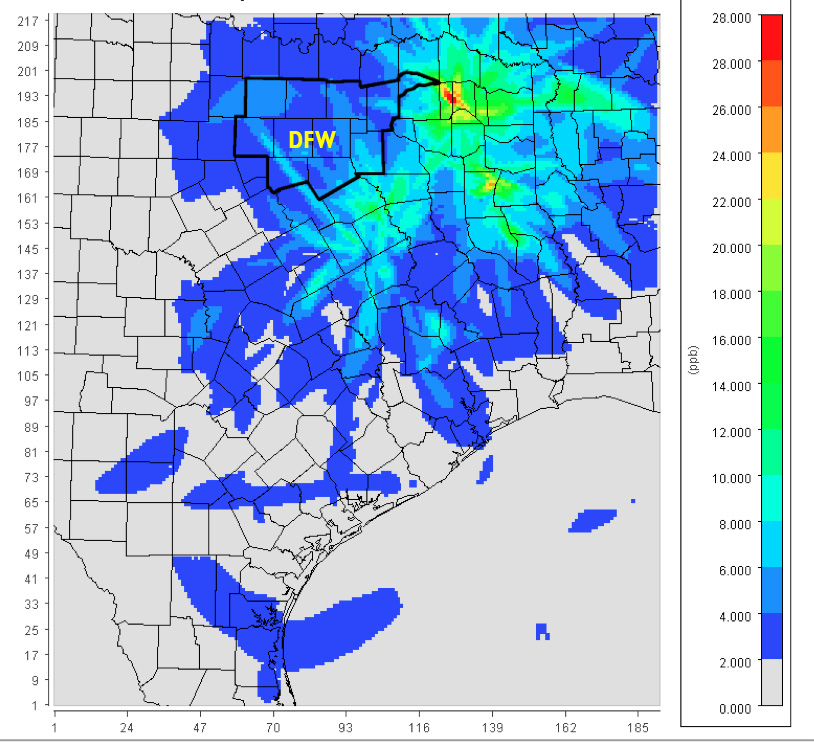 New evidence shows the huge impact the East Texas coal plants have on DFW air quality. Every scenario run by the UNT Engineering Department with the state's own DFW air computer model as part of Downwinder's Ozone Attainment Project demonstrates there's no more effective smog fighting strategy than reducing or eliminating the pollution from these coal plants.
New evidence shows the huge impact the East Texas coal plants have on DFW air quality. Every scenario run by the UNT Engineering Department with the state's own DFW air computer model as part of Downwinder's Ozone Attainment Project demonstrates there's no more effective smog fighting strategy than reducing or eliminating the pollution from these coal plants.
In fact, with a few other measures within the DFW area itself, controlling or eliminating their emissions could bring us in compliance with the 75 ppb standard, something that's not likely to happen otherwise.
Why is it so important to officially bring them into the DFW non-attainment area? Because major sources of pollution like coal plants are regulated differently inside than they are outside the area.
Right now, many DFW businesses are having to pay to operate and maintain pollution control equipment although most emit a tiny fraction of the pollution coming from the coal plants. That's because they're located in one of the ten counties in the DFW non-attainment area. They're held to a higher standard of control than their peers doing business outside those ten counties.
On the other hand, despite their large contribution to DFW's chronic ozone problem, the East Texas coal plants remain untouched by the same regulations and are not held to that higher standard. What sense does that make?
As much sense as it made to keep the cement plants out. As much sense as it made to try and exclude Wise County.
As per usual, the EPA is letting the state have first crack at defining a new DFW smog zone. The state has decided to leave the boundaries the way they are.
 Now, it's your turn to comment on that state decision, and tell Austin and the EPA – which will review the State's recommendations – what you think needs to happen.
Now, it's your turn to comment on that state decision, and tell Austin and the EPA – which will review the State's recommendations – what you think needs to happen.
The state is accepting comments on its decision until April 15th. This time, you can send your comments directly by e-mail instead of having to go through the official Texas Commission on Environmental Quality website
If you want to use our ready-to-send letter, all you have to do is CLICK HERE , sign the letter and add your own comments if you want. Then one more click and it's on it's way to Austin.
If you want to write your own comments:
EMAIL: kristin.patton@tceq.texas.gov
SNAIL MAIL: Kristin Patton, MC 206, State Implementation Plan Team, Office of Air, Texas Commission on Environmental Quality, P.O. Box 13087, Austin, Texas 78711-3087,
FAXED:(512) 239-6188.
All comments should reference "2015 Ozone NAAQS Designation Recommendations."
A Guide to the State’s War on the Clean Air Act
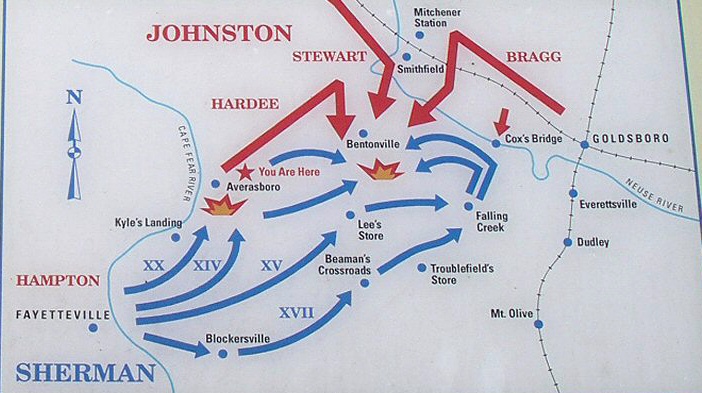 There's been a lot of activity lately on the many-fronted war the State of Texas is conducting against the Clean Air Act. What about a brief status report:
There's been a lot of activity lately on the many-fronted war the State of Texas is conducting against the Clean Air Act. What about a brief status report:
1) Mercury Rules
Thursday's headline was that Supreme Court Justice Roberts denied the attempt by Texas and 18 other states to delay the implementation of EPA's new, more protective limits on release of toxic Mercury pollution from coal plants. In 2013, three out of the top five largest Mercury polluters in the whole country were Texas coal plants.
It was only last summer that majority of the entire Court ruled EPA hadn't followed protocol in weighing costs to the coal industry versus public health benefits, and sent the standard back to the Agency to be rewritten. Not an especially big deal.
Texas, along with other states, sought an injunction from Justice Roberts to stop the timeline for implementation of the rules until the rewrite was finished. Roberts denied the request and so EPA is allowed to continue writing the rules and now expects to release the revised edition next month. One indication of how much trouble the rules are in, or not, is the speed and format of Robert's actions. He ruled on the case only a day after the EPA had submitted its brief, and ruled on it unilaterally, not bothering to convene the full Court.
The practical implications of the rules are reductions in the use of coal with higher Mercury content, better Particulate Matter pollution control equipment, and specific carbon absorption control technology aimed at Mercury. Many Texas coal plants have already taken steps to comply with the standards and it seems like almost all have applied for extensions to the original deadline.
2) Haze Rules
Earlier this week, Texas Attorney General Ken Paxton announced the state was suing the EPA for rejecting its lackadaisical plan to protect national parks from haze air pollution, also mostly coming from coal plants. Just three Luminant coal plants – Big Brown, Martin Lake and Monticello – release 40% of all Texas’ Sulfur Dioxide air pollution.
Late last year, EPA announced it found the state's lightning-fast 140-year plan to do absolutely nothing somehow inadequate, and begin to draft one of its own that would require "scrubbers" for Sulfur Dioxide pollution at nine coal plants across the state. It also concluded Texas had intentionally downplayed the impact of the coal plants on park air quality in computer modeling submitted to EPA .
Texas is suing to prevent the EPA from enforcing its plan to require scrubbers and asking the court to accept the original Texas plan as reasonable. Pending.
3) Sulfur Dioxide Non-attainment Areas in East Texas
In mid-February, EPA announced it intended to declare areas surrounding three East Texas coal plants as out of compliance with national Sulfur Dioxide pollution limits and declared them in official "non-attainment" of the Clean Air Act. Big Brown, Monticello, and Martin Lake power plants were found to be causing the violations in ambient air quality using computer modeling results first run by the Sierra Club, and then analyzed by the EPA. Boundaries were drawn for the new non-attainment areas that include all or parts of Freestone, Anderson, Rusk, Gregg, Panola, and Titus counties.
Final action by EPA on the non-attainment area classification is scheduled for this summer. Then it will be up to the state to submit a plan for action. We can all write the script from there. It ends in a court ruling.
Eventually, these East Texas non-attainment areas are another tool by EPA's to raise the costs of operating the oldest, most polluting coal plants to better reflect their toll on public health. Plants could lower their Sulfur Dioxide emissions by importing more "Cleaner Coal" from Wyoming and/or paying for those scrubbers the Haze Rules requires too.
4) DFW Clean Air Plan
DFW is in "non-attainment" for ozone, or smog pollution. It has been since 1991. The State has submitted a plan to EPA that sits back and watches federal fuel changes reduce smog-forming pollution by 20-40 tons per day. The problem? EPA estimates it will take cuts of 100-200 tons per day to get down to the current ozone standard of 75 parts per billion. The state says it sees no reason for more cuts.
This is the state plan up for comment at the the now infamous "F*** the TCEQ" public hearing in Arlington in late January, with final submission to EPA by the state this summer.
But between now and then one of the headlines you should see will be EPA rejecting the part of the state's plan dealing with pollution control technology. EPA has already telegraphed their intention to do so, and they don't have to wait for the state's final submittal deadline to act.
This will, of course, be followed by the state's suing the EPA for daring to enforce the Clean Air Act when Austin won't. But it won't keep the EPA from doing exactly what it did in the Haze Rule fight – write its own clean air plan for DFW.
And that will be our chance to make the greatest leap forward in local air quality in a decade.
How to Outflank HB40 in the Barnett Shale
 Last week, the EPA made an important admission.
Last week, the EPA made an important admission.
"Methane emissions from the oil and gas industry are significantly higher than previous official estimates, according to draft revisions of the U.S. greenhouse gas emissions inventory released Monday by the Environmental Protection Agency. At 9.3 million metric tons, revised estimates of 2013 emissions are 27% percent higher than the previous tally. Over a 20-year timeframe, those emissions have the same climate impact as over 200 coal-fired power plants."
This most recent analysis jives with other studies like the one from UTA/EDF that found Barnett Shale facilities leaking up to 50% more methane than previously estimated. In reaction to the information, EPA Chief Administrator Gina McCarthy was quoted as saying "we need to do more" to cut methane pollution.
In its last year in office the Obama administration is finally grasping that natural gas isn't the climate change wunderkind its promoters claimed and last week's announcement is the tacit admission they need to do more to crack down on oil and gas.
What has that got to do with DFW in 2016?
By Spring, the Regional office of the EPA is expected to announce that it has rejected the State's clean air plan for DFW in regard to its application of "Reasonably Available Control Technology." That means the state hasn't required the application of readily-available air pollution controls for major sources the way the Clean Air Act demands. Specifically, EPA staff have cited the failure of the state to lower the emission standards for the Midlothian cement kilns to reflect more modern technology. But it's not the only area where Texas fell short. There are no new pollution requirements for any oil and gas facilities in the state's plan either.
EPA rejection of the Technology section of the state's DFW air plan would mean the EPA would begin to draft its own clean air plan for the region. An EPA-drafted plan gives local citizens concerned about the health impacts of fracking an opportunity to persuade the Agency to use the plan to crack down on smog-forming Nitrogen Oxide (NOx) and Volatile Organic Compounds (VOCs) pollution in the Barnett Shale by requiring lower emission standards on all aspects of drilling and production.
While methane isn't considered a smog pollutant, it doesn't get emitted by itself. It comes out of a stack or valve, or leaks from a pipeline combined with smog-forming VOCs. So the more you control VOC pollution, the more you control methane pollution.
In light of last week's announcement, this gives EPA an extra incentive to go after VOC emissions in DFW even though the conventional wisdom is that it's combustion-generated Nitrogen Oxide pollution that really makes DFW smog so bad.
BTW, that conventional wisdom is under attack because the worst-performing air monitoring sites in North Texas are all in the Barnett Shale and heavily influenced by pollution from oil and gas facilities – both NOX and VOCs. It's possible to imagine a strategy to get smog numbers down in DFW solely by application of oil and gas emission regulations that can impact these important monitors – which drive the entire region's fate – even if the new regs have minimal impact on monitors elsewhere.
What kind of new regulations are we talking about?
* Start with the electrification of all 650 large natural gas compressors in the 10-county area.
* Do the same thing for all drilling rigs in the same 10-county area – nothing but electric.
* Emission standards for tanks and pipelines that reflect the latest leak-detection technology.
Inclusion of new EPA “Control Technique Guidelines" which are part of Agency's new methane rules. According to the Agency's release on the the new rules, “…reduction of VOC emissions will be very beneficial in areas where ozone levels approach or exceed the National Ambient Air Quality Standards for ozone."
Under the new rules, areas like DFW that host large concentrations of gas pollution sources and are officially categorized as “non-attainment” for smog receive "an analysis of the available, cost-effective technologies for controlling VOC emissions from covered oil and gas sources."
There's one more reason EPA has an incentive to go looking for all the cuts in oil and gas pollution it can find in the 10-county DFW non-attainment area: after the cement kilns, there's no other major sources the Agency can target locally.
Because while it has the authority in a federal clean air plan to regulate all pollution sources in that 10-county DFW non-Attainment area, the EPA can't write new emission standards for the East Texas coal plants located 100 miles outside of that 10-county area – even though those coal plants have more of an impact on North Texas smog than any other source of pollution. EPA (and us) can put pressure on the state to address these dinosaurs, but it can't touch them through a DFW air plan.
EPA staff has estimated it will take a cut of 100-200 TONS PER DAY in local smog-forming Nitrogen Oxide pollution for DFW reach the current 75 parts per billion smog standard. The State's "plan" – i.e. the federal gasoline fuel changes it relies on – only represents a 20-40 tons per day cut.
Where do the other 60 -160 tons a day in cuts come from?
To give you some idea of the size of that gap, the state estimates that all on and off road vehicles in the 10-county area will emit 161 tons per day of NOx in 2018.
State-of-the-art controls on all the cement plants might give you up to 15 tons a day. Electrification of the large compressors, another 15-16 tons per day eventually. After that it gets hard to find large volumes of cuts without the coal plants. And this is why the EPA should give cuts in VOC/methane a longer look than they have before – they're concentrated in the same areas where the region's worst-performing monitors are and they represent a huge source of climate change pollution that could also be another skin on the wall in addition to lowering smog levels.
There's no question the passage of HB40 has stymied grassroots progress toward more protective regulation of fracking by municipal governments in the Barnett Shale. It's thrown what was a fairly successful local movement into disarray. To date, there doesn't appear to be any consensus about strategies to combat the effects of the legislation.
But a way to outflank some of the impacts of HB 40 coming is coming down the pike, and it offers local fracktivists an opportunity to rally round a common, achievable goal – lowering emission levels across the board in the Barnett Shale. We can overlay a larger, stricter regional template for oil and gas regulation in place of 100 separate municipal ones.
What better way to nullify the efforts of the nullifiers in Austin?
COG’s Michael Morris Criticizes “Vulgar” Comments from Citizens, But Not a Vulgar Air Plan from TCEQ
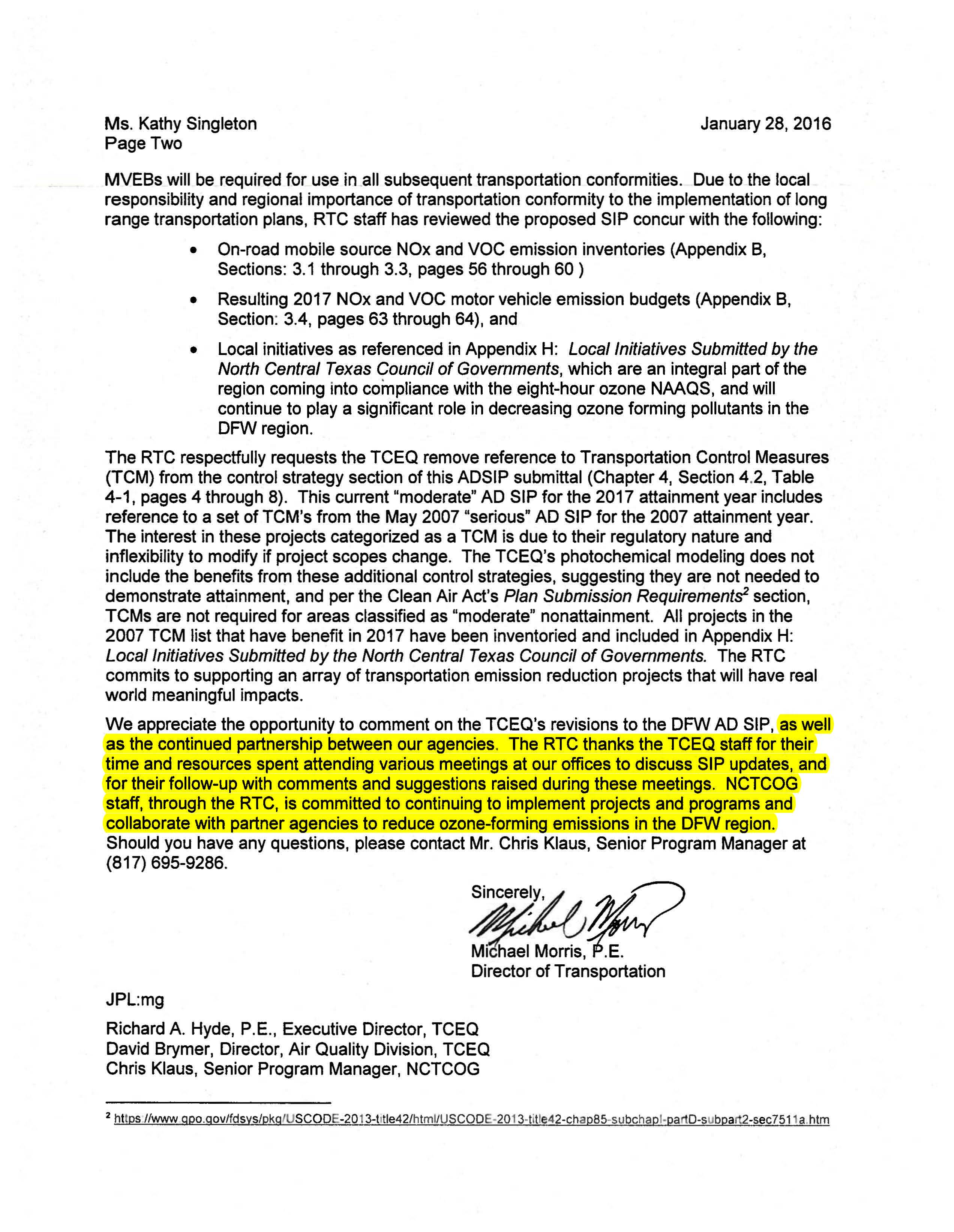 Don't look now, but Michael ("never met a freeway proposal I didn't like") Morris, the long-time Director of Transportation for the North Central Texas Council of Governments, has gotten a case of the Vapors.
Don't look now, but Michael ("never met a freeway proposal I didn't like") Morris, the long-time Director of Transportation for the North Central Texas Council of Governments, has gotten a case of the Vapors.
Was it some new threat to the Trinity Tollroad that sent Mr. Morris into a tizzy? Some "regional mobility" crisis?
No, nothing as small-minded as those examples.
Instead it's the "vulgar" language used by DFW residents in the state's public hearing on its new do-nothing air plan on January 21st that makes Mr Morris so darn mad he feels he has to apologize to the Texas Commission on Environmental Quality for it in a letter last month.
You see the hearing took place at NCTCOG headquarters in Arlington, in the COG conference room Mr. Morris uses to rule his freeway fiefdom from as the force behind the Regional Transportation Council.
We suspect that almost everyone official, including Mr. Morris, thought it would be another dreary affair when the conference room was offered up as a hearing space. But citizens had other ideas. After 20 years of failure, they weren't in any mood to accept another "plan" from the state that required no new pollution controls on any sources. They were mad as hell, and they weren't going to take it anymore.
No question more than one person uttered words and phrases you will not hear in Church. These were intentional and meant to shock everyone out of official complacency in another just-going-through-the-motions regulatory exercise. Commentators were following the advice of John Maynard Keynes: "Picturesque language, used right, serves an important purpose. Words ought to be a little wild, for they are the assaults of thoughts on the unthinking."
"Unthinking" is a generous way to describe the State's air plan.
Far from being "meaningless," as Morris' letter to the TCEQ asserts, the use of "bad words" at the hearing on the 21st was packed with decades of frustration. They meant something precisely because they had never been uttered before in such a place by people who had worked in good faith for so long on DFW's chronic smog problem. They meant something because citizens realize they no longer have anything to lose in calling out the State for its shamelessness. It meant something because the story that was told by employees the next day at TCEQ HQ in Austin and EPA HQ in Dallas was not the usual script for these things, but how badly the State got its ass kicked, and how genuinely angry the crowd was that nothing was being done about DFW bad air – again.
"Bad words" put an exclamation point on a problem. They can also unmask the Killing-Us-Softly language and protocol the TCEQ uses to make decisions that harm the public health. They pull back the curtain and give a more accurate, if less polite, perspective. If some citizens were dropping F-bombs toward the TCEQ at the hearing, they were only giving as good as they were getting.
Because make no mistake about it, in the way the State has drafted and approved this plan, it's making it's own bold declaration of F*** YOU to EPA and seven million DFW breathers.
By conservative estimates, the State's air plan for DFW needed to cut up to 200 tons per day or more of smog-forming pollution to get the the current ozone standard by the deadline of 2017. Instead the state is submitting a plan that gets only 20-40 tons per day of cuts – all from a change in federal gasoline rules. The EPA had already warned Texas in writing that the plan didn't include new, lower emission limits for the Midlothian cement kilns, and this exclusion would mean the plan was not meeting the Clean Air Act. The State submitted the same plan anyway.
But there was no criticism of this obscene gesture in Morris' letter. Instead he says he looks forward to working in continued partnership with the TCEQ – a partnership which has produced five (going on six) failed air plans and over twenty years of non-compliance with the Clean Air Act. Huzzah.
And that's why citizens were right to call out the TCEQ the way they did on the 21st. Here's an agency, COG, that's nominally, but officially assigned the role of local consultants on air planning for seven million DFW residents, and it's taking a complete whiff on the State's clear-eyed strategy of nullifying the Clean Air Act. If it can't even bring itself to mildly criticize the state for submitting a plan that's, you know, both unworkable and illegal, what other choice do citizens have but to scream bloody murder at the top of their lungs?
We're proud to have played a part in making DFW a hostile work environment for the political hacks who now run and staff the Texas Commission on Environmental Quality. They don't deserve to have an easy time of it. They should fear being run out on a rail or verbally tarred and feathered every time they make an appearance here. It's the only way citizens have to effectively show how they feel about a government that not only isn't listening, but has no interest in listening.
It's also activity protected by the First Amendment, a technicality that Morris seems like he's desperate to address for fear of his conference room being sullied by another severe outbreak of democracy.
And that's the thing about Morris' response. He's very concerned about the bad words. Not so much about the bad air.
You could put all the F-bombs dropped on the 21st on hundreds of billboards next to schools, and churches, and Mr. Morris' beloved freeways, where thousands would see and be offended by them. You could broadcast them over a loud speaker going through "nice" neighborhoods. You could open a website devoted to nothing but evangelizing their use or a cable channel that repeated them 24/7. You could assault people from every direction with bad words every waking minute of their day, and you'd still be doing less harm to the public than even one more month of dirty air courtesy of the state, and Mr. Morris's silence.
As for those citizens who were there on the 21st to give the start a hide tanning it deserved, maybe they were taking Jane Jacobs lesson to heart: "We had been ladies and gentlemen and only got pushed around."
When Was the Last Time you Saw This?
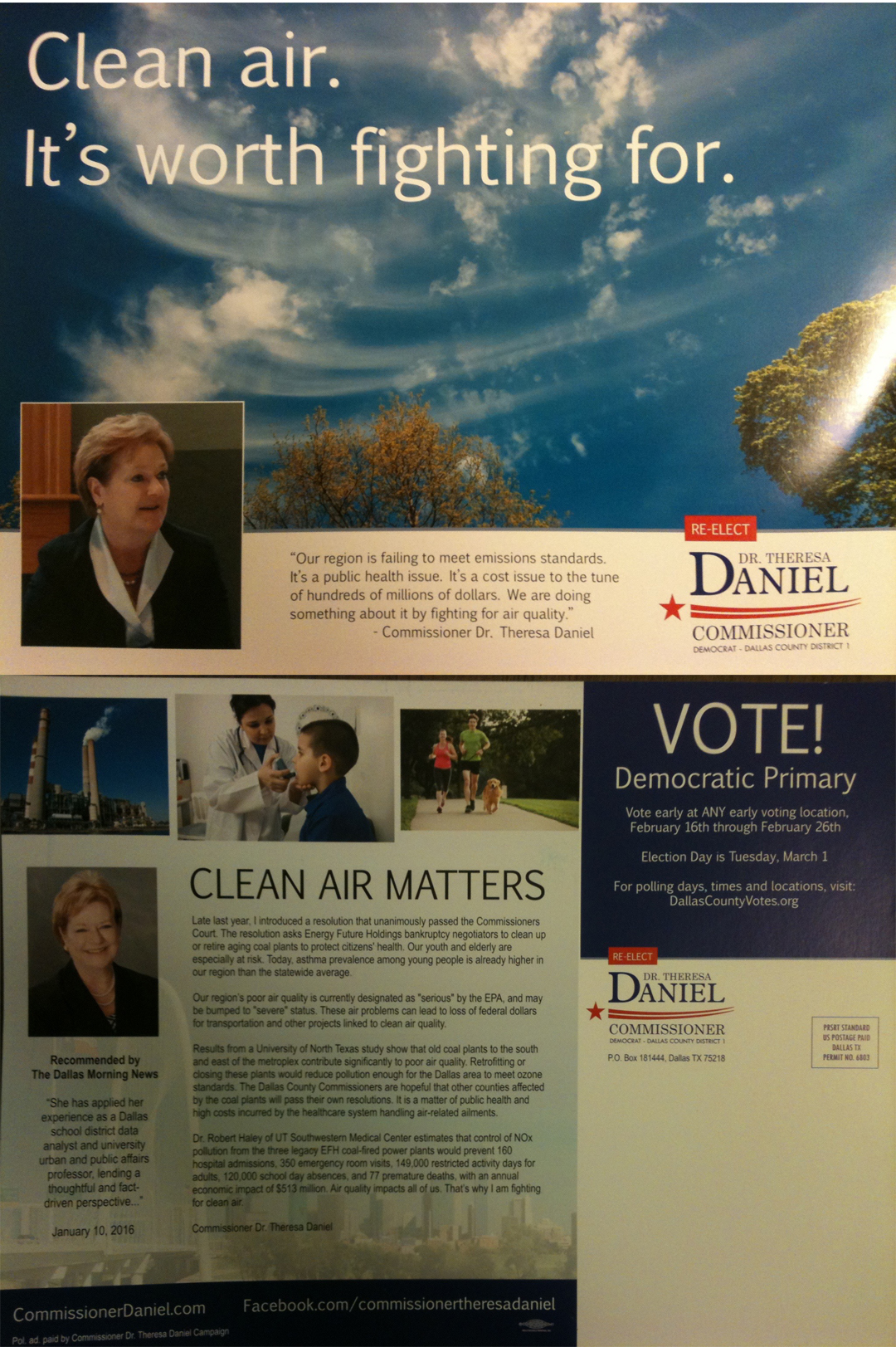 Can you even remember the last time you received a DFW political mailer that spoke about the value of air that won't make you sick or kill you, much less a whole piece devoted to the subject? Neither can we. That's what makes this mailer from incumbent Dallas County Commissioner Dr. Theresa Daniel so welcome.
Can you even remember the last time you received a DFW political mailer that spoke about the value of air that won't make you sick or kill you, much less a whole piece devoted to the subject? Neither can we. That's what makes this mailer from incumbent Dallas County Commissioner Dr. Theresa Daniel so welcome.
In an oversized 9 x11 mailer that went to 5 to 6000 households in District 1, under the headline, "Clean Air. It's Worth Fighting For," Daniel states, "Our region is failing to meet emissions standards. It's a public health issue. It's a cost issue to the tune of hundreds of millions of dollars. We are doing something about it by fighting for air quality."
On the back are four – count 'em – four paragraphs discussing the recent UNT local air quality study Downwinders sponsored, as well as Dr. Robert Haley's associated examination of the costs of dirty air, and the County Court resolution sponsored by Daniel last November asking the judge overseeing the Energy Future Holdings (Texas Utilities) bankruptcy case to clean-up the company's old East Texas lignite coal plants due to their large impact on DFW smog.
This pairing of issue to elected official is a consequence of Downwinders' Ozone Attainment Project, which produced the UNT study, but also put together a committee of local leaders to oversee it. Former Dallas County Judge Margaret Keliher chaired it. During her time in office about a decade ago, Keliher was the most influential local leader on air quality. She rode roughshod over what is now seen as the most effective clean air plan in DFW's two-decade old struggle to meet clean air standards – the one that came closest to working, however fleetingly. With her institutional knowledge of the issues and process, one of the co-benefits of Judge Keliher chairing our UNT study committee was being able to mentor a new generation of local elected officials on air quality.
Commissioner Daniel was one of the most active and vocal members of that committee. By her own admission, she didn't know a lot about air quality at the beginning, but she kept coming to the committee briefings and learning. Over the last year, she's become more confident in her understanding of the DFW dirty air narrative, to the point of now leading meetings with other officials.
Daniel and her fellow Project Committee member Dallas County Councilwoman Sandy Greyson have become a new dynamic duo for the cause of regional air quality. They represent a brand new wave of local leadership on the issue – one that has been sorely lacking even as DFW sunk deeper into chronic dirty air thanks to a state government that doesn't think smog is that big of a deal. You may remember that Greyson testified at the recent Arlington hearing on the State's do-nothing smog plan, and Daniel sent her Chief of Staff to speak. Had they not served on the Keliher/UNT Committee, it's likely neither would have even known about the event.
Even as they become more active, they're drawing more of their peers into the discussion – County Commissioners and City Council members in other parts of the "non-attainment area." For the first time in this decade, clean air has some serious advocates at the local level
Downwinders had a plan. We wanted to take away the state's exclusive power over the model that drives all the clean air decisions for the region and educate elected officials about the importance of winning the fight over chronic smog. We not only got an unprecedented study that used the State's own data to contradict it's conclusions about no new controls needed – we got at least two strong elected officials as new advocates for the cause that were in on that exercise from the beginning.
We didn't know Commissioner Daniel was going to send this mailer out, but it's one more beneficial side effect of grinding things out on a local level.


